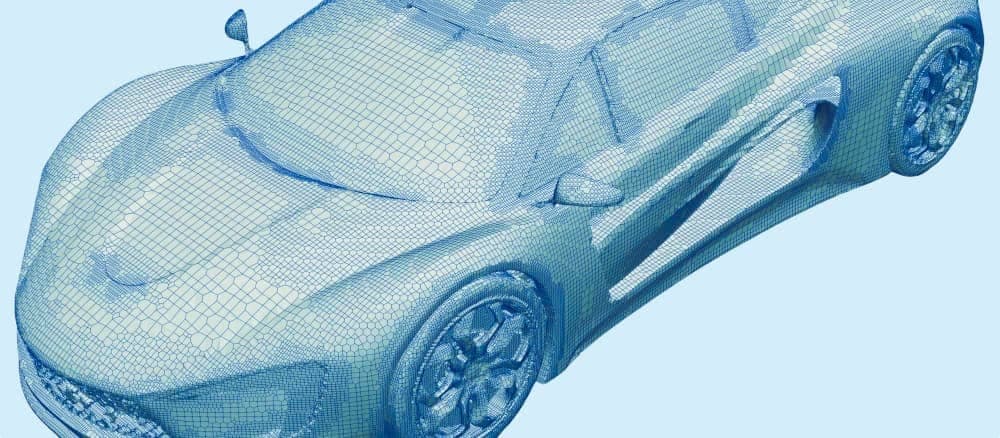Engineering of a backpack ventilation technology for cycling using CFD analysis
Frank I. Michel1, Wouter Remmerie2, Matthias Kimmerle3
1 VAUDE Sport GmbH &Co. KG, i-team, Germany (www.vaude.com)
2 AirShaper, Antwerp, Belgium (www.airshaper.com)
3Albstadt-Sigmaringen University, Faculty of Engineering, Albstadt, Germany
Introduction
Thermoregulation of an athlete during physical activities plays an important role especially in endurance sports such as cycling. Depending on the kind and intensity level of the activity thermoregulation can affect performance and/or thermal comfort. During cycling, especially within the MTB categories, athletes often wear a backpack. Weder et al. (2018) emphasizes that even wearing a backpack during cycling has a significant impact on athlete’s thermoregulation. However, Defraeye et al. (2011) underlines the complexity of thermo-physiological measurements due to a variety of influencing factors. Therefore, they recommend a 3D modelling process in combination with computational fluid dynamics (CFD) analysis to evaluate and optimize ventilated backpack technologies. The overall goal of the study was to engineer a new backpack ventilation technology utilizing the relative headwind generated during cycling for convective heat transfer between backpack and first clothing layer.
Material & Method
The avatar was generated with MakeHuman™ and imported with standard rig in Blender™ for posing on a bike (Fig. 1). The anthropometrics of the avatar were derived from Australian track cyclists (MC Lean and Parker 1989). CFD Analyses were done at AirShaper™ using a steady-state RANS (Reynols Averaged Navier Stokes) method with k-omega SST turbulence model. The boundary conditions used are: wind speed: 5.5 ms-1; air temperature: 15°C, air density: 1.225 kgm3; atmospheric pressure: 101300 Pa. The focus of this study was on the upper body including the pelvis of the cyclist. To focus computational power on this area, the model was cut off just below the saddle and a moving ground was applied to avoid artificial flow effects. The qualitative evaluation of the simulation was focused on the general flow patterns (3D trajectories of “air particles”) and the pressure and velocity profiles around the torso. 3D turbulence patterns were also taken into account. No thermal effects or humidity were considered, and local velocities were used as the prime indicator for local thermal convection.
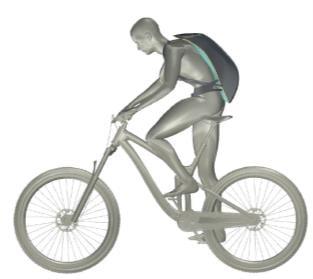
Results
The CFD analysis of rider without backpack (Fig. 2) revealed that the air flow across the shoulders rejoins after the neck & head of the rider to then speed up and stay attached down the center part of the back to at least some extent (Fig. 2b) towards the spine region. A second air flow that showed potential to improve convective heat transfer is the one that curves around the sides of the torso (Fig. 2e, f). This suggests that the new backpack design should catch the high velocity air flow around the shoulder & neck to then guide the air towards the spine region. Additionally, for the second concept (AirTurbulencer) laterally placed air vents were aimed at catching & guiding the air streams going around the sides of the torso towards the spine region and then to the lumbar region of the back.
Fig. 3 shows that both the AirStreamer and the AirTurbulencer concept allow & promote an airstream along the spine region coming from the shoulder towards the lumbar region. The main air stream is aligned with the spinal region. The flow going around the torso however was already detached & highly turbulent when it reached the side inlets of the backpack (Fig. 4). This could cause a reduction in thermal, although turbulent air is typically more capable for thermal cooling performance.
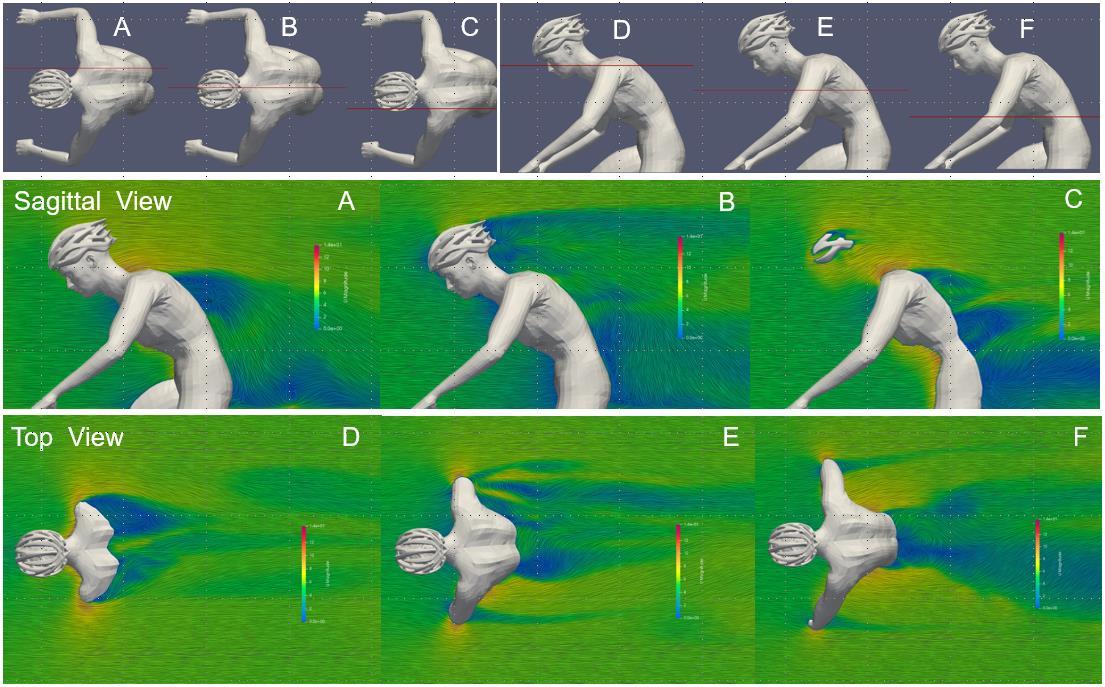

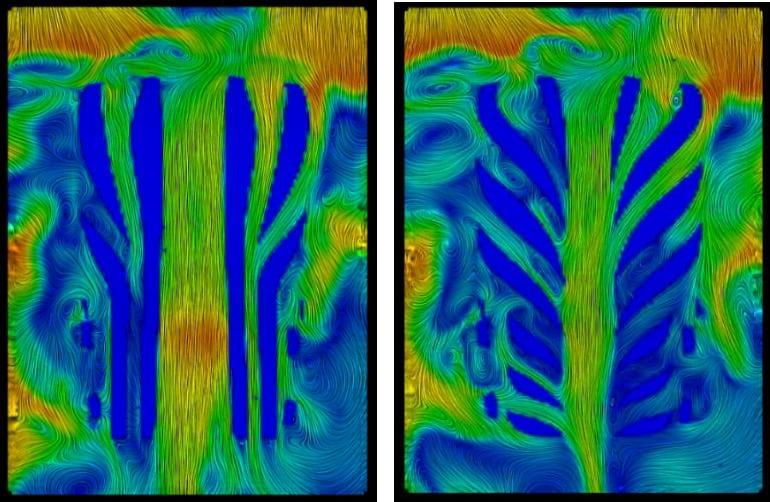
Discussion & Conclusion
Defraeye et al. (2011) demonstrated – based on CFD analysis - that headwind affects the convective heat transfer during cycling and hence it has an influence on thermo-physiological response of the cyclist. The current CFD study also shows the possibility to utilize the headwind generated during cycling as a driving force for convective heat transfer. Moreover, the CFD analysis clearly points out that local backpack design affects the airstream pattern between the back and the backpack.
The CFD analysis of the AirStreamer as well as the AirTurbulencer concept (Fig. 5) exhibit the potential to influence the convective heat transfer especially around the spine region in a positive way during cycling. However, the CFD study was focused on the velocity patterns as an indication for thermal performance, not taking the actual thermal behavior into account. The next step comprises a study with real athletes measuring the micro and the interlayer climate by means of temperature and humidity monitoring during cycling in a climate chamber. Such a study is necessary to confirm the findings of the CFD analysis.
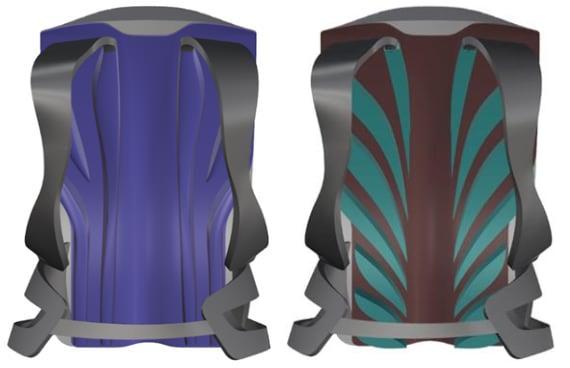
References
Defraeye et al. (2011) J. Computational fluid dynamics analysis of drag and convective heat transfer of individual body segments for different cyclist positions. J Biomech 44(9):1695-701.
McLean BD, Parker AW (1989) An anthropometric analysis of elite Australian track cyclists. Journal of Sports Sciences 7(3):247-55.
Weder et al. (2018) Thermophysiological comfort of cycling backpacks. In: IB Mekjavic (Ed) Physiology and Pharmacology of Temperature Regulation (PPTR) - 7th International Meeting (40). Split, Croatia.
SCIENCE & Cycling Conference, 3rd – 4th July 2019, Brussels - Belgium
Download Original Paper
